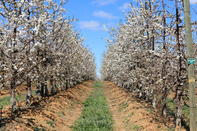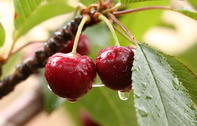Sweet cherries (Prunus avium) are native to parts of Europe, Turkey, Africa and Asia, but the earliest known reference of cherries was in 372-272 B.C. indicating the first cherries may have been cultivated in ancient Greece.

The dark-red to nearly black sour cherries or tart cherries (Prunus cerasus) are mainly grown for cooking and baking and grow on smaller trees. Sour cherries are said to be more nutritious than sweet cherries and are especially rich in melatonin.
In South Africa, only sweet cherries are produced, with the bulk of production coming from the cold regions around the town of Ceres. However, it is the Free State town of Ficksburg, that is most famous for its production of glazed cherries, and annual Cherry Festival, which is held in November.
Cherry Farming in South Africa
According to records the first small cherry orchard in South Africa, was planted in the Gydo Pass outside the Western Cape town of Ceres, in 1890. However, the first commercial production of cherries in South Africa, started in 1904, near Clocolan in the Free State Province.
Here, about five hectares of cherries were planted, by Harry Pickstone, with the help of German missionaries. Cherry farming has been growing ever since. In just one year between 2017 and 2018 planting increased by 25% to a total of 388 ha.
There are around 30 cherry production units in South Africa, managed by 23 commercial producers, with a total cherry production of just over 1 000 tonnes in the 2018/19 season.
There has been an increase of 76%, in cherry production between 2013 and 2018, this is mainly due to funding by the alternative crop fund of the Western Cape's department of agriculture.
Funding has helped increase the availability of cherry tree rootstocks, registering of suitable chemicals for use on cherry trees and collection of cherry data in South Africa. Research is mainly done by the South African Cherry Growers Association (SACGA) and Hortgro. Current research includes adaptability studies to determine cherries' adaptability in different climate regions.
In South Africa cherry farming is confined to specific areas due to the climatic requirements for this sensitive crop. Cherries need mild summers and long cold winters, with enough cold units for a long dormancy of below 7°C. These factors confine cherry farming to the high-lying regions around Ceres in the Western Cape, as well as the Free State, and Northwest, plus smaller areas in Limpopo, Gauteng and Mpumalanga Provinces.
Cherries are a quick ripening crop, with only 55 - 70 days from pollination to harvest, depending on cultivar. Harvesting is labour-intensive; cherries need to be hand-picked to keep the stem intact. They must be very quickly cooled down to 0.5°C, to ensure a shelf life, suitable for export to the UK, the main market, the Middle East, Europe and Russia.
Cherry Cultivars

Sweet cherry farming in South Africa started with the planting of cherry cultivars such as Early River, Early Red Five, Giant Heidelfinger and Bing. Of these, the large dark-red Bing and black-red Giant Heidelfinger are still planted.
There are a large number of varieties planted in South Africa, these include Royal Hazel, Royal Dawn, Royal Lynn, Royal Edie and Royal Helen. The varieties such as Van and Sweet Ann are used as cross-pollinators. The earliest cultivar is Royal Tioga and the cherry season concludes with Stoccato.
The most popular tart cherry cultivar (in the USA) is Montmorency.
According to the ‘Cherry Industry Overview’ prepared by Hortgro in July 2019, the main cherry variety in South Africa, grown by an individual producer, is the red flavourful newcomer Royal Hazel.
Which is a variety with a good shelf life, is suitable for shipping, and is already making up 10% of South Africa’s total plantings, of just under 390 hectares (2019). Other cherry cultivars also planted on large scale include Royal Edie en Royal Helen.
By Marinda Louw